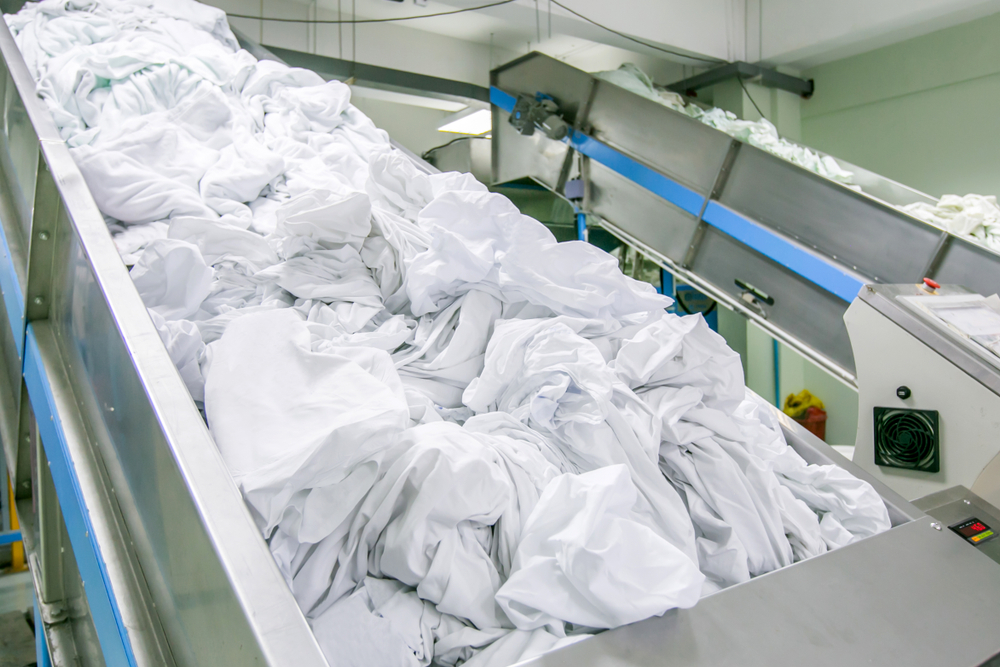Bedding Cleaning vs. Clothes Cleaning Commercially

Commercial cleaning of bedding and clothing involves distinct processes, each tailored to the specific requirements and materials involved. While both are integral to the hospitality and healthcare industries, among others, understanding the differences can illuminate why certain items are handled in particular ways and the importance of specialized cleaning techniques.
Commercial Cleaning of Bedding
Commercial cleaning of bedding, which includes items such as sheets, duvet covers, and pillowcases, is designed to ensure that these items not only appear clean and inviting but are also hygienic and free from allergens, bacteria, and other pathogens. This is especially critical in settings like hotels and hospitals, where cleanliness directly impacts user experience and health.
High-Temperature Washing: Bedding is typically washed at high temperatures, often exceeding 60°C (140°F), to kill dust mites and bacteria effectively. This high-temperature wash is crucial for sanitizing the bedding, a step that’s essential in commercial settings to meet health and safety standards.
Gentle Detergents and Bleaching Agents: Although the wash is aggressive in terms of temperature, the detergents used are often gentler than those used for regular clothing. This is because bedding materials, particularly those used in luxury accommodations, can be delicate. Additionally, bleaching agents are frequently employed to ensure whiteness and to assist in disinfecting.
Large Capacity Machines: Commercial laundries use large-capacity machines that can handle bulky items like comforters and blankets, ensuring thorough cleaning and rinsing. The use of these machines also allows for the processing of vast quantities of bedding simultaneously, a necessity in high-demand environments.
Specialized Drying and Ironing: After washing, bedding is dried in commercial dryers with precise temperature control to prevent shrinkage and maintain fabric integrity. Then, items are often ironed or pressed to remove wrinkles, presenting a crisp, clean appearance crucial for guest satisfaction in hotels and resorts.
Commercial Cleaning of Clothes
In contrast, commercial cleaning of clothes encompasses a broader range of garments, from uniforms and linens to personal clothing items. The focus here extends beyond just cleanliness and hygiene; maintaining the color, shape, and overall quality of the garments is also paramount.
Variable Temperature Washing: Clothes are washed at various temperatures depending on the fabric type and color. This variability ensures that garments are cleaned effectively without causing shrinkage, color bleeding, or damage to delicate fabrics.
Specific Detergents and Treatments: Commercial laundering of clothes often involves specialized detergents and stain removers tailored to the type of garment and the stains being treated. For instance, enzymatic detergents may be used to break down protein-based stains on restaurant linens.
Garment-Specific Processes: Clothes undergo garment-specific processes, including dry cleaning for items that cannot be washed with water, spot treatments for stains, and repairs for damaged items. This level of care helps extend the lifespan of the garments, which is especially important for items like uniforms that see heavy use.
Finishing Touches: Clothes are also finished according to the requirements of the fabric and the preferences of the client. This can include tumble drying, hang drying, steam pressing, or dry ironing to achieve the desired finish and texture.
Key Differences
The primary differences between commercially cleaning bedding and clothes lie in the objectives and processes involved. For bedding, the focus is on achieving a high level of hygiene and presenting an immaculate appearance, with processes designed to sanitize and whiten these items thoroughly. In contrast, cleaning clothes commercially involves a greater emphasis on individual garment care, with customized processes to treat stains, protect delicate fabrics, and maintain the garment’s overall quality and appearance.
Moreover, the equipment and detergents used may vary significantly between the two, with bedding requiring large-capacity machines and high-temperature washes, and clothing needing a variety of machines and cleaning methods to cater to different materials and stains.
In conclusion, while both bedding and clothing are essential components of commercial laundry services, the approaches to cleaning them differ considerably. Understanding these differences is crucial for businesses in selecting the right laundry service provider and ensuring that their textiles are cared for appropriately, whether for aesthetic appeal, hygiene standards, or fabric preservation.
